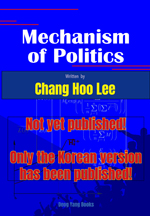Chapter 0 Contents of this
book

(1) Political Phenomenon's
Scope and Explanation Method
In this book, I will not explain everything
about politics, nor will I go into depth about anything
outside of politics. What I want to explain is political
phenomenon. Then, what is considered political phenomenon?
Where does it start and where does it end?
On January 1st, 1959, the underground
organization following Castro took complete control
of the capital, Havana. When the frontal assault of
the guerrilla squad started on August 21st, 1958,
with only 800 soldiers, they were numerically inferior
and weak compared to the government army, but they
fought fiercely and received strong support from the
Cuban people. Eventually, they conquered the Cuban
government. This belongs to political phenomenon.
What about the following events? Are they political
events?
In June 2016, Venezuela showed severe
income inequality. According to a report by The Washington
Post, "Starving Venezuelans eat fruit from the
trees or catch animals such as dogs and cats, birds.
Bread shops and supermarkets are frequently robbed."
On the other hand, "Well-off Venezuelans are
purchasing household items directly through American
online sites or receiving deliveries through family
members living in the United States." Is this
a political event? On the other hand, in the 14th
century in Joseon, Confucian scholars wrote famous
Buddhist criticism works such as "Bulsijapbyeon
(ÝÖä«íÚÜ©; Buddhistic Miscellaneous Debates)". Is
this also a political event?
The wealth gap in Venezuela is essentially
an economic event, and the writings of Buddhist critics
are fundamentally academic or religious events. However,
there is also a political aspect to this. Venezuela's
extreme wealth gap holds the power to trigger changes
in the regime, and the publication of Buddhist critics
in Korea helped restrict the political participation
of Buddhist priests and promote the politics of Neo-Conficianism.
As seen in the case, where the trade deficit with
China has become a political issue in the United States
or Pope Urban II had an impact on the Investiture
Controversy and the First Crusade through his theories
regarding the papacy, this is a universal phenomenon.
Then, what exactly is the "political
aspect"? As most political scientists agree,
it is about having influence on power. As will be
mentioned again, political phenomena are directly
related to power phenomena. Focusing on power phenomena,
the scope of political phenomena can be described
as follows.
| |
[Ch.0.2] In a political
phenomenon, political actors interact according
to the properties of their capacities and enhance
their own power structure (cooperative relation)
for both individual and shared profit. The change
of power structure is influenced by internal and
external factors and it undergoes temporal changes
according to the demands of political actors.
|
IIn this paragraph, two points are
focused on for understanding the power phenomenon:
¨ç the 'power structure' and ¨è its 'change'. The power
structure refers to an organization of people's cooperative
relations and is also called a "political regime."
Its change is determined by environmental factors
(internal and external) and members' demands (cooperation).
Explaining the operating principle
of the political phenomenon with spatial-temporal
universality of East and West, past and present, and
the macro?micro-level universality in large and small
areas requires a significant level of abstractness
in and of itself. Instead, the value of scientific
study can be obtained there.
This book expresses very new ideas.
I have organized the content of this book into a simple
structure and used all concepts with the most consistent
meaning. Furthermore, I am explaining by repeatedly
applying the simplified concept system to multiple
parts. So, I thought many people would easily understand
the contents of this book, but to my surprise, that
was not often the case. The reason is one and only
one: it is very different from the existing political
science theory.
New ideas are always difficult to
understand. When seen from experience, when something
is said to be "easy to understand," it means
that at least 80% of what it means is familiar to
oneself. To overcome this problem as much as possible,
I will make use of many diagrams and tables in this
book to easily convey its systematic and clear thoughts.
Through tables and diagrams, you
can often see at a glance what I mean by what I say.
Especially in this book, the content explains complex
phenomena by repetitively applying simple concepts.
Even if the reality is actually very simple, it can
be difficult to understand. In this case, showing
the relationships between each concept with tables
and diagrams seems to be effective. Once you understand
the contents of this book, I wonder if the contents
will still be summarized just by looking at the tables
and figures included in this book.
The important statements that penetrate
the entire book, together with tables and figures,
are collected in the appendix at the end of the book
for this reason.
  
|